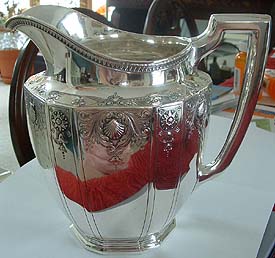
Sterling silver is an alloy composed by weight of 92.5% silver and 7.5% other metals, usually copper. The sterling silver standard has a minimum millesimal fineness of 925.

Nickel silver, maillechort, German silver, argentan, new silver, nickel brass, albata, or alpacca is a cupronickel alloy with the addition of zinc. The usual formulation is 60% copper, 20% nickel and 20% zinc. Nickel silver does not contain the element silver. It is named for its silvery appearance, which can make it attractive as a cheaper and more durable substitute. It is also well suited for being plated with silver.

A silversmith is a metalworker who crafts objects from silver. The terms silversmith and goldsmith are not exact synonyms, as the techniques, training, history, and guilds are largely the same but differed in that the end product may vary greatly.
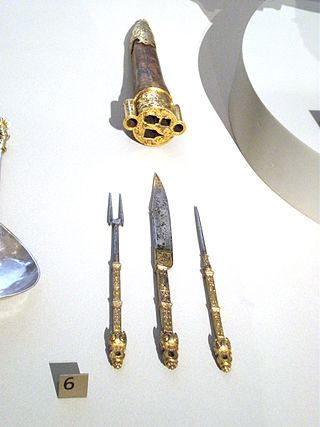
Cutlery includes any hand implement used in preparing, serving, and especially eating food in Western culture. A person who makes or sells cutlery is called a cutler. While most cutlers were historically men, women could be cutlers too; Agnes Cotiller was working as a cutler in London in 1346, and training a woman apprentice, known as Juseana.
A hallmark is an official mark or series of marks struck on items made of metal, mostly to certify the content of noble metals—such as platinum, gold, silver and in some nations, palladium. In a more general sense, the term hallmark is used to refer to any standard of quality. Not to be confused with responsibility marks that are the marks of the maker.
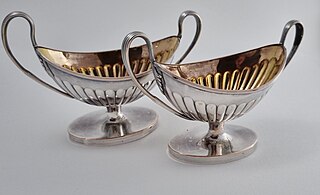
Old Sheffield Plate is the name generally given to the material developed by Thomas Boulsover in the 1740s, a fusion of copper and sterling silver which could be made into a range of items normally made in solid silver. The material rapidly gained popularity as a substitute for solid silver, as it was much cheaper to produce. Any object made in silver could in effect be made in Old Sheffield Plate, although objects subject to heavy wear such as spoons and forks were not so satisfactory in plate.

Britannia metal is a specific type of pewter alloy, favoured for its silvery appearance and smooth surface. The composition by weight is typically about 92–93% tin, 5–6% antimony, and 2% copper. Some sources use the terms "Britannia metal" and "britannium" to mean different things.

The Gorham Manufacturing Company was one of the largest American manufacturers of sterling and silverplate and a foundry for bronze sculpture.
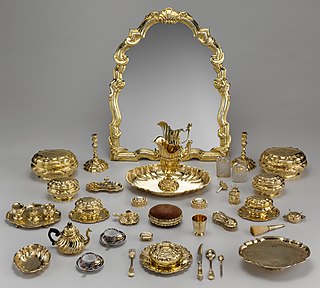
Household silver or silverware includes tableware, cutlery, and other household items made of sterling silver, silver gilt, Britannia silver, or Sheffield plate silver. Silver is sometimes bought in sets or combined to form sets, such as a set of silver candlesticks or a silver tea set.

Christofle is a luxury French silverware and tableware company founded in Paris in 1830 by Charles Christofle.

Martelé is a limited hand-wrought production line of silver.

A silver object that is to be sold commercially is, in most countries, stamped with one or more silver hallmarks indicating the purity of the silver, the mark of the manufacturer or silversmith, and other (optional) markings to indicate the date of manufacture and additional information about the piece. In some countries, a national assayer's office controls the testing of silver objects and marking of purity.
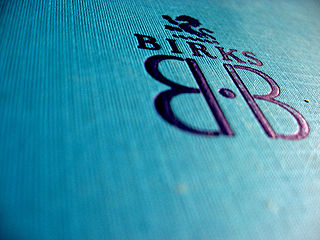
Birks Group Inc. is a designer, manufacturer, and retailer of jewellery, timepieces, silverware and gifts, with stores and manufacturing facilities located in Canada and the United States. The Group was created in November 2005 through the merger of Henry Birks and Sons Ltd. (Canada) and Mayors Jewelers Inc..
Alfred de Courcy was a Birmingham whistle maker from 1888 to 1927, who founded the company A de Courcy & Co. He was the largest whistle maker beside J.Hudson & Co. from 1906 until 1927, when Hudson bought out the whistle-making part of the company.

J Hudson & Co was founded in the 1870s in Birmingham by Joseph Hudson (1848–1930) and his brother James Hudson (1850–1889). The company became a manufacturer of whistles and continues as Acme Whistles. Acme is the world's largest and most famous producer of whistles. They are headquartered in the Jewellery Quarter district of Birmingham, England.
Henry Arthur Ward (1838–1903) was a Birmingham whistle maker who made whistles of high quality, all rare and hard to find. He made whistles from 1876 to 1903.

Cornish Place is a listed building situated in the Neepsend area of the City of Sheffield. The building was formerly the factory of James Dixon & Sons, a Britannia metal, Sheffield plate and Cutlery manufacturer. In the late 1990s the disused building was cleaned and converted into apartments, it is regarded as the most impressive cutlery works that still stands in Sheffield and rivals the cotton mills of Lancashire and the West Riding in terms of architectural quality and heritage. The east and west ranges of the structure are the most spectacular, with Grade II* listed classification, while the rest of the works receive the lower Grade II category. The "Cornish" in the buildings name is thought to derive from the manufacture of Britannia metal which is made up of 93% tin which came from Cornwall.

Leah's Yard is a retail and trading hub, and former collection of small industrial workshops situated on Cambridge Street in the city centre of Sheffield in South Yorkshire, England. The building has been designated as a Grade II* listed building and has been noted for its importance as an example of Sheffield's industrial heritage. It has recently undergone a significant restoration to bring it back into use.
R. Wallace & Sons (1835–) was formed in Wallingford, Connecticut, and incorporated in 1879. As of 1893, this company manufactured silver and plated ware and cutlery and had about 600 employees.

Anthony Rasch von Tauffkirchen was a German-American silversmith, active in Philadelphia (1804-1820) and New Orleans (1820-1858). According to the Metropolitan Museum of Art, his works are credited with being "among the most sophisticated silver vessels produced in the United States in the early nineteenth century."
















